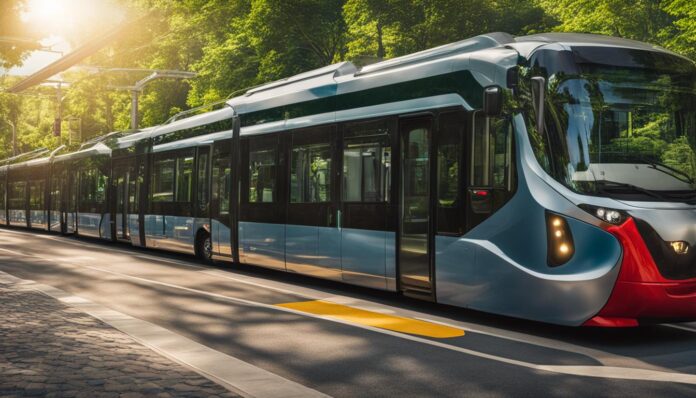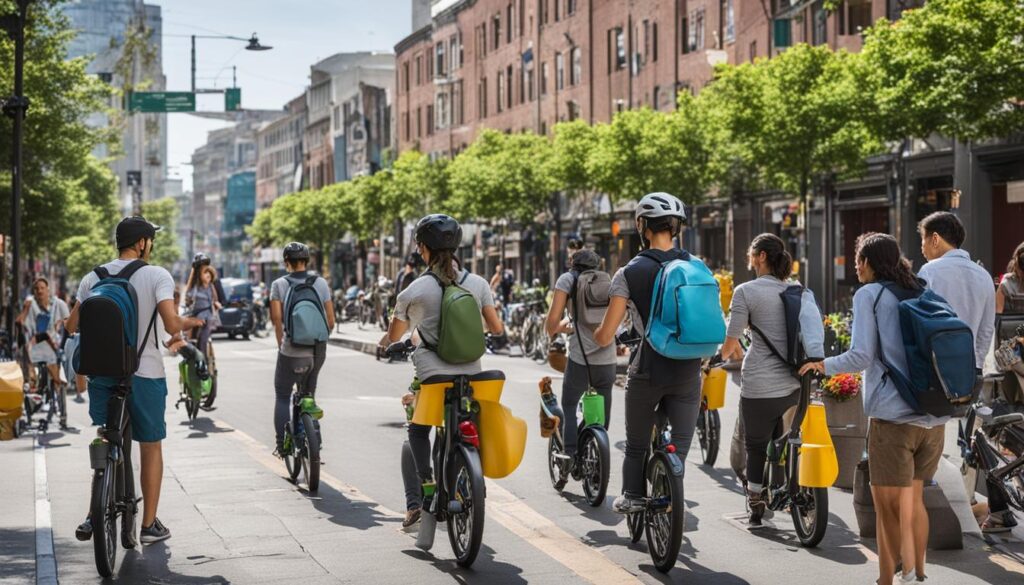Looking for options to commute sustainably and reduce your carbon footprint? Embrace eco-conscious travel with low-carbon choices. Thankfully, there are various sustainable travel transportation options available that can make your commutes and journeys greener. Say goodbye to conventional modes of transportation and shift to eco-friendly options that are better for the planet and your health.
From biking to electric vehicles and carpooling, sustainable transportation solutions are available to fit every lifestyle and need. By opting for eco-friendly transportation, you can contribute to preserving our planet, one ride at a time. Read on to discover more about the benefits of choosing greener alternatives to conventional travel modes.
Why Choose Eco-Friendly Transportation?
When it comes to transportation, opting for eco-friendly choices is crucial to reducing carbon emissions and creating a sustainable future. Green travel methods like biking, walking, carpooling, and public transportation have numerous benefits, including:
- Reducing air pollution
- Conserving energy
- Cutting fuel costs
- Promoting physical activity and overall health
- Reducing traffic congestion
Not only do these eco-friendly transportation options benefit the environment and personal health, but they also have a positive impact on the community as a whole. Choosing to use public transportation, for example, can free up road space and relieve traffic congestion for those who must drive. It’s a win-win situation.
There are several greener alternatives to conventional travel modes, and embracing these choices can make a big difference in mitigating climate change. So why not make a switch to eco-friendly transportation and help create a brighter future?
Sustainable Travel Modes for Commuting
Embrace environmentally friendly commuting and explore green alternatives to reduce your carbon footprint. Incorporating sustainable travel modes into your daily commute not only benefits the environment but also promotes a healthier and more active lifestyle. Here are some options to consider:
| Mode of Transport | Environmental Impact | Health Benefits | Cost |
|---|---|---|---|
| Biking | Zero emissions | Great cardiovascular exercise | Low cost for bike purchase and maintenance |
| Walking | Zero emissions | Reduces stress and improves mental health | Free |
| Carpooling | Reduces individual emissions | Promotes social interaction | Cost-sharing |
You can also consider combining multiple modes of transportation, such as biking to a bus or train station and then using public transportation to complete the journey. This can further reduce your carbon footprint and provide a convenient and sustainable travel option.
Tip: Before opting for a sustainable travel mode for commuting, consider the distance, availability, and feasibility of the mode of transportation.
Public Transportation: A Greener Option
Choosing public transportation as an alternative to driving your car is a great way to reduce your carbon footprint and contribute to a more sustainable future. Public transportation options such as buses, trains, and trams offer many environmental benefits, including lower carbon emissions and reduced traffic congestion in urban areas.
By using public transportation, you are also reducing the number of cars on the road, which helps to reduce air pollution and decrease the demand for fossil fuels. In addition, many public transportation agencies have started to invest in sustainable transportation solutions, such as hybrid or electric buses and trains, to further reduce their environmental impact.
Environmental Benefits of Public Transportation
According to research, using public transportation can be up to six times more energy-efficient than driving a car. Public transportation options can also help to conserve land and reduce the need for new highways and roads.
| Environmental benefit | Public transportation | Personal vehicle |
|---|---|---|
| CO2 emissions per passenger mile | 0.32 pounds | 0.88 pounds |
| Energy consumption per passenger mile | 3,782 BTUs | 17,340 BTUs |
| Land use per passenger mile | 0.21 square feet | 1.45 square feet |
As the table shows, public transportation options have much lower CO2 emissions and energy consumption per passenger mile than personal vehicles, making them a sustainable transportation choice.
Choosing Public Transportation for Eco-Conscious Travel
If you’re looking for eco-conscious travel options, choosing public transportation is a great place to start. Not only is it more sustainable than driving alone, but it can also save you money and reduce the stress of navigating traffic.
Next time you plan on taking a trip, consider choosing a public transportation option instead of driving your car. You’ll be doing your part to contribute to a more sustainable future while still getting to your destination.
Embracing Electric Vehicles
If you’re looking for green travel methods, electric vehicles (EVs) are a great eco-friendly travel mode worth exploring. These vehicles run on electric motors powered by rechargeable batteries, eliminating direct emissions of pollutants compared to traditional combustion engines. By choosing an electric car, bike, or scooter, you can reduce your carbon footprint while still enjoying the convenience of personal transportation.
Electric cars and bikes, in particular, are gaining popularity, thanks to advances in battery technology that allow for longer ranges and faster charging times. Charging points are also becoming more prevalent in public areas, making it easier to recharge your vehicle while out and about.
Did You Know? The first electric vehicle was invented in the late 1800s and outsold gasoline-powered cars until the 1920s.
In addition to being environmentally friendly, electric vehicles offer several other benefits, such as reduced fuel costs and lower maintenance expenses. While the initial purchase price may be higher than a conventional vehicle, the long-term savings may make it a smart investment in the future of sustainable travel.
Types of Electric Vehicles:
| Type | Description |
|---|---|
| Electric Cars | Cars that run exclusively on electric motors and rechargeable batteries. |
| Electric Bikes | Bicycles with an electric motor and rechargeable battery to assist with pedaling. |
| Electric Scooters | Scooters with an electric motor and rechargeable battery for propulsion. |
With the increasing popularity of electric vehicles, it’s worth considering this option when looking for eco-friendly travel modes. Not only do they offer a sustainable and convenient way to get around, but they also contribute to a greener future.
Going Car-Free: Sustainable Urban Living
Living in a city requires a lot of transportation, but owning a car is not your only option. More and more urban dwellers are adopting a car-free lifestyle, relying on alternative transportation methods and enjoying the benefits that come with it. With low-carbon travel choices and eco-friendly transportation, going car-free is a smart choice for both your wallet and the environment.
One of the biggest benefits of going car-free is the cost savings. Car ownership can be expensive, with payments, gas, and maintenance costs adding up quickly. By using public transit, walking, or biking instead, you can save money while also reducing your carbon footprint. Not only is this better for the environment, but it’s also better for your health.
Did you know? Choosing to bike instead of drive can save you up to $9,000 per year on transportation costs.
Another advantage of going car-free is the reduced stress and improved quality of life. Eliminating the time and hassle of driving and finding parking can free up time for other activities and hobbies. Walking and biking can also provide you with daily exercise, which can boost your mood and overall well-being.
| Transportation Method | Carbon Emissions (per passenger mile) |
|---|---|
| Car | Up to 0.89 lbs |
| Public Transit | 0.23 lbs |
| Bike | No carbon emissions |

Overall, going car-free is a sustainable and eco-conscious choice that benefits both individuals and communities. By adopting low-carbon travel choices and embracing alternative transportation methods, you can contribute to a more sustainable and healthier urban environment.
Emphasizing Sustainable Air Travel
If you’re planning a trip by air, there are ways to minimize its environmental impact. It is possible to make the journey greener with sustainable travel transportation options. This includes reducing carbon emissions and supporting carbon-neutral transportation alternatives.
One way to limit the carbon footprint of air travel is by utilizing carbon offset programs. These programs work by supporting eco-friendly initiatives that decrease carbon emissions, like planting trees or creating renewable energy sources. Airline companies like Delta and United have already implemented carbon offset programs for customers and actively commit to reducing their emissions.
Another option is to choose airlines that prioritize eco-conscious travel options, such as JetBlue Airways and Azul Brazilian Airlines. These airlines are dedicated to investing in sustainable fuel sources and minimizing their overall carbon footprint.
Carbon Emissions Comparison: Major Airlines
| Airline | CO2 Emissions per Passenger Mile |
|---|---|
| Delta | 0.22 lbs |
| United | 0.24 lbs |
| JetBlue Airways | 0.19 lbs |
| Azul Brazilian Airlines | 0.20 lbs |
While air travel remains a significant contributor to carbon emissions, it’s promising to see airlines and travelers alike making strides towards more sustainable travel. By making informed choices and supporting carbon-neutral transportation, we can all contribute to a greener future.
Eco-Friendly Transport Sharing Services
Transport sharing services have revolutionized the way we commute and travel. Eco-friendly travel modes like car-sharing, bike-sharing, and ride-sharing provide sustainable transportation options that reduce the need for private vehicles and lower your carbon footprint. By sharing rides and vehicles, you can save money, reduce congestion, and minimize the environmental impact of travel.
Moreover, with the ongoing pandemic, transport sharing has emerged as a responsible and safe way to travel, minimizing contact and controlling the spread of the virus. The emergence of electric bikes, cars, and other vehicles for sharing has further added to the convenience and sustainability of transport-sharing services.
The Benefits of Eco-Friendly Transport Sharing Services
Here are some advantages of using eco-friendly transport sharing services:
| Benefits | Eco-friendly Transport Sharing Services | Private Vehicles |
|---|---|---|
| Reduces carbon footprint | ✔ | ❌ |
| Cuts travel costs | ✔ | ❌ |
| Saves maintenance and parking costs | ✔ | ❌ |
| Minimizes congestion | ✔ | ❌ |
| Reduces stress | ✔ | ❌ |
| Enhances social connections | ✔ | ❌ |
Transport sharing services help in promoting sustainable and responsible travel options that can lead to a cleaner and greener environment, particularly in crowded urban areas. They provide an efficient and practical alternative to the use of personal cars and contribute to a collective movement towards green travel methods.
“Transport sharing services are not just about sustainable transportation but also about building a sharing economy. By conserving resources, reducing waste, and promoting social interactions, transport sharing services lead the way towards a better, healthier, and happier future.”
Integrating Technology for Sustainable Travel
Technology has played an important role in revolutionizing sustainable travel. With the help of innovative apps, platforms, and tools, you can now make eco-friendly transportation choices and navigate greener routes. These advancements have enabled people to reduce their carbon footprint and contribute towards a more sustainable future.
Smart Navigation and Route Planning
Apps like Google Maps and Waze now provide options for cyclists, pedestrians, and public transportation users that allow you to select the most efficient and environmentally friendly routes to your destination. Electric vehicle (EV) owners can use apps like ChargeHub and PlugShare to search for nearby charging stations and plan their route accordingly.
| Benefits | Examples |
|---|---|
| Lower carbon emissions | Google Maps, Waze |
| Easier EV charging station access | ChargeHub, PlugShare |
Car and Bike Sharing Platforms
Car and bike-sharing services like Zipcar, Lime, and Bird provide a sustainable transportation solution that reduces the need for private car ownership and promotes the sharing economy. By renting a car or bike only when you need it, you save the resources required for maintenance, insurance, and parking of a private vehicle, making it a more environmentally friendly commuting option.
| Benefits | Examples |
|---|---|
| Reduced carbon emissions | Zipcar, Lime, Bird |
| Less need for private car ownership | Zipcar, Lime, Bird |
Smart Parking
Parking management platforms like ParkWhiz and SpotHero not only help you find parking spots quickly but also provide real-time information on parking prices and availability. This reduces the amount of time cars spend circling around for parking spaces, subsequently reducing traffic congestion and emissions.
| Benefits | Examples |
|---|---|
| Reduced traffic congestion and emissions | ParkWhiz, SpotHero |
| Time-saving search | ParkWhiz, SpotHero |
By incorporating technology into sustainable transportation solutions, we can make more informed and efficient choices, ultimately contributing towards a healthier planet.
Investing in Sustainable Infrastructure
Investing in sustainable infrastructure is pivotal for promoting eco-conscious travel options and sustainable transportation solutions. Initiatives and developments in public transportation, cycling infrastructure, and electric vehicle charging networks have the power to reshape the way we commute and travel, minimizing our carbon footprint and promoting a greener future.
In recent years, numerous cities and countries have implemented sustainable infrastructure projects to promote low-carbon travel choices. Copenhagen, for example, has invested in a cycling infrastructure that prioritizes bike-friendly routes and ensures amenities like secure parking facilities, making cycling a mainstream mode of transportation. Amsterdam, one of the most bicycle-friendly cities in the world, has developed an extensive network of bike paths and even offers bike-sharing services.
Some cities have also prioritized public transportation as a key component of sustainable infrastructure. Singapore, for instance, has an extensive public transportation system that includes buses, trains, and trams. Dubai has also invested in its tram system, making it accessible to residents and tourists alike. The result is a decrease in reliance on personal vehicles and a reduction in carbon emissions.
The growth in electric vehicles has also been fueled by the development of sustainable infrastructure. Governments and private entities have been investing in electric vehicle charging networks to make EVs accessible and convenient for drivers. In some cities, municipalities have installed curbside charging facilities. In others, private companies have opened charging stations in parking lots and garage facilities.
Sustainable Infrastructure Initiatives
| Location | Initiative |
|---|---|
| Copenhagen, Denmark | Extensive cycling infrastructure with bike-friendly routes and parking facilities |
| Amsterdam, Netherlands | Extensive network of bike paths and bike-sharing services |
| Singapore | Comprehensive multi-modal public transportation system |
| Dubai, United Arab Emirates | Improved tram system for more accessible public transportation |
| Various locations | Development of electric vehicle charging networks for wider EV adoption |
The benefits of investing in sustainable infrastructure are manifold. Besides building a more sustainable world, greener transportation options lead to a higher quality of life, improved public health, and reduced traffic congestion. It’s time to recognize that promoting low-carbon travel choices and establishing sustainable transportation solutions requires comprehensive investment in sustainable infrastructure.
Promoting a Collective Mindset
Choosing low-carbon travel choices and eco-friendly travel modes, while not the easiest option, is vital for our planet’s future. And while the responsibility may seem too significant for any one person to bear, in reality, everyone has a role to play in promoting sustainable transportation.
This is where collective action comes into play. Community initiatives, advocacy, and education can help create a sustainable transportation environment and promote low-carbon travel choices.
“The journey of a thousand miles begins with a single step.” – Lao Tzu
To make the most significant impact, you need to prioritize eco-friendly transportation choices. Join groups such as bicycle or walking clubs or take advantage of carpooling options. You can also reach out to local and state officials to fund bike paths, community buses, and walking trails.
The Power of Advocacy
Advocacy is one of the most potent tools in creating sustainable transportation environments. If you’re passionate about eco-conscious travel options, find an advocacy group or start your own. Use social media to connect with like-minded individuals and influence policy change.
| Advantages of Advocacy: | Actions to Consider: |
|---|---|
| Get involved in local politics | Attend rallies and local events |
| Influence policies and regulations | Spread awareness on social media |
| Partner with businesses and organizations | Support eco-friendly transportation programs |
Education for Sustainable Transportation
Education is critical in promoting eco-friendly transportation.
Children should be taught sustainable habits from a young age, such as walking, biking, and carpooling. Schools can introduce initiatives that encourage low-carbon travel choices, such as bike-to-school programs, eco-contests, and teaching safe travel options.
Adult education is also essential and can include workshops, meetings, and online resources. The more we learn about the environmental impact transportation can have, the more driven we are to promote eco-conscious options.
Conclusion
As you can see, there are plenty of sustainable travel transportation options available for you to choose from. By opting for eco-friendly transportation methods, you can significantly reduce your carbon footprint and help contribute to a greener future.
Whether it’s biking, walking, carpooling, using public transportation, or investing in electric vehicles, there are plenty of low-carbon travel choices available to you. You can also take advantage of transport sharing services or integrate technology to facilitate eco-friendly travel.
It’s important to embrace a collective mindset in achieving sustainable travel goals. Community initiatives, advocacy, and education all play a role in promoting eco-conscious transportation choices.
Investing in sustainable infrastructure is also crucial in developing greener transportation solutions. Initiatives and developments in public transportation, cycling infrastructure, and electric vehicle charging networks all contribute to a more sustainable world.
By making small changes to your daily commute or travel plans, you can do your part in promoting sustainable travel. Let’s work together towards a greener future.
















































